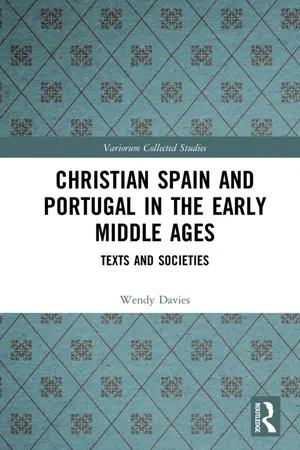1
THE EARLY MIDDLE AGES AND SPANISH IDENTITY
The middle ages have for a long time been seen as a critical period in the formation of modern Spain.1 The creation, expansion, and consolidation of the Christian kingdoms of the north and of the county of Castile, movements characteristic of the ninth, tenth, and eleventh centuries, are held to lay the basis for the unification of Spain in the sixteenth century, the Spanish Empire and the transmission of Spanish culture overseas. The images of territorial expansion, Christian self-confidence and the settlement of a desert have seemed to be essential to understanding what makes Spain Spain. Indeed, the distinctiveness of Spain was a recurrent preoccupation of Spanish historians in the twentieth century: what made Spain different from the rest of Europe?2 Different it obviously seemed to be, given the strength of continuing cultural contacts with Spanish America and given its civil war, its long period of dictatorship, its particular brand of Catholicism, and its very strong regional identities. For most historians, what made Spain different was the distinctiveness of its medieval past, a past of overt cultural and political conflict between Christians and Moslems, and a past in which the almost total Moslem conquest of 711 was gradually, across many centuries, overturned by the ‘centuries-long frontier struggle between Christians and Moslems’: ‘Reconquest [is the] key to the history of Spain’.3 Indeed, the view is not confined to historians and still colours the way many modern Spaniards think of themselves, even if it is to maintain that Spain is no longer different.4
In what follows I shall firstly consider the major issues that have absorbed medieval historians in the twentieth century; I shall then take a look at twentieth-century political developments, at the use of the medieval past by twentieth-century politicians, and at the interaction of both with history writing; and I shall finally consider the fate of historians’ preoccupations of the twentieth century and the issues that remain to be resolved. The interplay between contemporary politics and history writing is subtle – and unusually important.
Writing medieval history
Medieval historians had different approaches to the past, and twentieth-century history writing is marked by sustained debates about it.5 The most prominent debate, and the most influential, is that between Américo Castro and Claudio Sánchez-Albornoz, largely conducted in mid-century. Castro argued that the peculiar identity of Spain derived from the integration of Christian, Moslem, and Jewish cultures, which had interacted with each other to produce a new culture during the course of the reconquest across the ninth to thirteenth centuries.6 This interaction was creative, he maintained, and determined the future quality of the Spanish, for the earlier Roman and Visigothic traditions had been wiped out by the very fact of the Arab incursion and settlement. Sánchez-Albornoz, by contrast, argued that the identity of Spain was marked by different characteristics from those of other western European states and derived from a Spanishness that had developed in antiquity. The palaeolithic had been ‘more unified ethnically and culturally than people supposed’ and the Roman period saw further manifestations of the temperament of homo hispanus; despite the apparently dramatic political changes, there were cultural continuities from that time and a quintessentially Hispanic culture survived the Arab onslaught.7 Both historians agreed, however, that the medieval development of Spain had been different from that of western Europe as a whole, for Spain did not share Europe’s feudal characteristics. For Sánchez-Albornoz pre-feudal development was beginning much as it did elsewhere in Europe but was cut off by the invasion of 711 and its consequences; for Castro the ideology of feudalism was completely inappropriate and Spain showed no signs of the class conflict that he held accompanied feudalism elsewhere.8 Here then was another critical difference in Spanish development – it had no feudalism.
One sub-theme of the debate, although it was much more strongly associated with Sánchez-Albornoz than with Castro, was that of depopulation and repopulation. In response to the initial Moslem incursion, King Alfonso I of Asturias (739–57) adopted a policy of strategic depopulation in Galicia and in the large expanse of the Duero basin, he argued. Moslem conquest provoked further Christian migration, particularly from the Duero valley (see figure 0.1), the Christian population of Hispania fleeing north to the inhospitable Cantabrian mountains and north-west to the farthest corner of Galicia, leaving vast expanses of unoccupied and depopulated land. As Christian kings slowly won back territory in the central middle ages, the Hispanic population gradually returned from the north to the deserted lands, reinforced by Mozarabic settlers from southern Spain, and together they restored settlement and agriculture.9 This was colonization of the frontiers in a truly American sense and Sánchez-Albornoz exploited the parallels. Like the American pioneers, the colonizers brought a spirit of freedom to central Spain and their settlements became free communities of small-scale proprietors.10 This free peasant spirit did much to determine the distinctive qualities of Spanish society in the central middle ages and even beyond: ‘an island of freemen in a Europe in the process of feudalization’; ‘a major factor in forging the Spaniard and his differentiation from the man beyond the Pyrenees’.11
Belief in depopulation and repopulation was highly influential, at scholarly and popular levels, until very recently; the approach has affected most aspects of the interpretation of social and political change in the early middle ages. Even in the late twentieth century distinguished scholars wrote about depopulation beginning already in the later seventh century (that is before the Moslem incursion), about desertion caused by the Arabs, about families who colonized ‘deserted lands’ in the ninth and tenth centuries and about repopulation.12 School textbooks of the twenty-first century detail the abandonment of lands occasioned by the Moslem conquest and the subsequent repopulation of extensive territory in the ninth and tenth centuries, especially in the Duero basin.13
